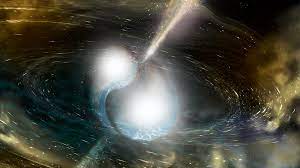The collision of neutron stars, cataclysmic events that send ripples through the fabric of spacetime, offers more than just a spectacular light show. According to research from Washington University in St. Louis, these cosmic collisions serve as a gateway to uncovering new physics, potentially shedding light on the mysterious realm of dark matter.
In a study published in Physical Review Letters, physicist Bhupal Dev and his team delve into the aftermath of a neutron star merger known as GW170817, a monumental event detected by gravitational wave observatories like LIGO and Virgo, as well as numerous telescopes across the globe.
Neutron star mergers, characterised by the fusion of two incredibly dense stellar remnants, create a fleeting hot and dense environment ripe for the production of exotic particles. One such particle of interest is the axion-like particle, a hypothetical entity that emerges from extensions of the standard model of physics. These elusive particles are prime candidates for comprising a portion, if not all, of dark matter, the invisible substance that makes up the majority of the universe’s mass.
Drawing on observations from GW170817, Dev and his team propose a novel method for constraining the properties of ALPs. When neutron stars collide, they generate a maelstrom of debris, including newly formed ALPs. These particles, which escape the chaotic aftermath of the collision, eventually decay into familiar particles like photons.
By analyzing the electromagnetic signals emitted by these decaying ALPs, the researchers can distinguish them from the background noise of the universe. Leveraging data from gamma-ray telescopes such as NASA’s Fermi-LAT, the team derived new constraints on the axion-photon coupling, providing valuable insights into the nature of these enigmatic particles.
The implications of this research extend beyond astrophysics, offering a tantalizing glimpse into the fundamental building blocks of the cosmos. With the potential to unlock the secrets of dark matter, neutron star mergers emerge as cosmic laboratories for probing the frontiers of physics.
future gamma-ray missions, including the WashU-led Advanced Particle-astrophysics Telescope hold the promise of further elucidating the properties of ALPs and advancing our understanding of the dark sector of the universe.
In the words of Dev, “Extreme astrophysical environments, like neutron star mergers, provide a new window of opportunity in our quest for dark sector particles like axions, which might hold the key to understanding the missing 85% of all the matter in the universe.”
